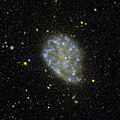NGC 4242
| NGC 4242 | |
|---|---|
 Hubble image of NGC 4242 | |
| Observation data (J2000 epoch) | |
| Constellation | Canes Venatici |
| Right ascension | 12h 17m 30.174s[1] |
| Declination | +45° 37′ 09.46″[1] |
| Redshift | 0.00176[1] |
| Heliocentric radial velocity | 527 km/s[1] |
| Distance | 17.78 ± 0.65 Mly (5.45 ± 0.20 Mpc)[2] |
| Group or cluster | Canes II Group |
| Apparent magnitude (V) | 11.37[3] |
| Apparent magnitude (B) | 10.83[3] |
| Characteristics | |
| Type | SABdm[4] |
| Apparent size (V) | 5.0′ × 0.38′[3] |
| Other designations | |
| NGC 4242, UGC 7323, MCG +08-22-098, PGC 39423[5] | |
NGC 4242 is a spiral galaxy in the northern constellation of Canes Venatici. The galaxy is about 18 million light years (5.5 megaparsecs) away.[2] It was discovered on 10 April 1788 by William Herschel,[7] and it was described as "very faint, considerably large, irregular, round, very gradually brighter in the middle, resolvable" by John Louis Emil Dreyer, the compiler of the New General Catalogue.[8]
NGC 4242's galaxy morphological type is SABdm. This means that it is an intermediate spiral galaxy, with loosely wound spiral arms and is generally irregular in appearance. It was photographed by the Hubble Space Telescope in 2017.[9] The image shows an asymmetric center and a small galactic bar.[9] NGC 4242 has a relatively low surface brightness and rate of star formation.[9] NGC 4242 may be a satellite galaxy of Messier 106[10] and is a member of the Canes II Group.[11][12]
SN 2002bu was detected in NGC 4242, brightening to its peak magnitude of 15.5 in 2002.[13] It was originally classified as a type II supernova,[13] but it may be a supernova impostor, like SN 2008S.[14]
Gallery
-
NGC 4242 by GALEX
-
NGC 4242 by the Sloan Digital Sky Survey
-
Hubble Space Telescope image of NGC 4242.
References
- ^ a b c d Adelman-McCarthy, J. K.; et al. (2009). "VizieR Online Data Catalog: The SDSS Photometric Catalog, Release 7". VizieR On-line Data Catalog. Bibcode:2009yCat.2294....0A.
- ^ a b Tully, R. Brent; et al. (2013). "Cosmicflows-2: The Data". The Astronomical Journal. 146 (4): 86. arXiv:1307.7213. Bibcode:2013AJ....146...86T. doi:10.1088/0004-6256/146/4/86. S2CID 118494842.
- ^ a b c Gil De Paz, Armando; et al. (2007). "The GALEX Ultraviolet Atlas of Nearby Galaxies". The Astrophysical Journal Supplement Series. 173 (2): 185–255. arXiv:astro-ph/0606440. Bibcode:2007ApJS..173..185G. doi:10.1086/516636. S2CID 119085482.
- ^ Ann, H. B; Seo, Mira; Ha, D. K (2015). "A Catalog of Visually Classified Galaxies in the Local (z ∼ 0.01) Universe". The Astrophysical Journal Supplement Series. 217 (2): 27. arXiv:1502.03545. Bibcode:2015ApJS..217...27A. doi:10.1088/0067-0049/217/2/27. S2CID 119253507.
- ^ "NGC 4242". SIMBAD. Centre de données astronomiques de Strasbourg. Retrieved 14 April 2018.
- ^ Yang, S.-C; Sarajedini, A (2012). "HST/WFPC2 Imaging of the Dwarf Satellites And XI and And XIII : HB Morphology and RR Lyraes". Monthly Notices of the Royal Astronomical Society. 419 (2): 1362. arXiv:1109.2038. Bibcode:2012MNRAS.419.1362Y. doi:10.1111/j.1365-2966.2011.19792.x. S2CID 119190619.
{{cite journal}}: CS1 maint: unflagged free DOI (link) - ^ Seligman, Courtney. "New General Catalogue objects: NGC 4200 - 4249". cseligman.com. Retrieved 10 April 2018.
- ^ "Revised NGC Data for NGC 4242 - Hartmut Frommert - SEDS". seds.org. Retrieved 14 April 2018.
- ^ a b c "Dim and diffuse | ESA/Hubble". www.spacetelescope.org. 2017. Retrieved 14 March 2018.
- ^ Spencer, Meghin; Loebman, Sarah; Yoachim, Peter (2014). "A Survey of Satellite Galaxies Around Ngc 4258". The Astrophysical Journal. 788 (2): 146. arXiv:1404.7222. Bibcode:2014ApJ...788..146S. doi:10.1088/0004-637X/788/2/146. S2CID 118622457.
- ^ P. Fouque; E. Gourgoulhon; P. Chamaraux; G. Paturel (1992). "Groups of galaxies within 80 Mpc. II - The catalogue of groups and group members". Astronomy and Astrophysics Supplement. 93: 211–233. Bibcode:1992A&AS...93..211F.
- ^ "The Canes II Group". www.atlasoftheuniverse.com. Retrieved 2018-04-16.
- ^ a b "SN 2002bu". SIMBAD. Centre de données astronomiques de Strasbourg. Retrieved 14 April 2018.
- ^ Smith, Nathan; Li, Weidong; Silverman, Jeffrey M; Ganeshalingam, Mohan; Filippenko, Alexei V (2011). "Luminous blue variable eruptions and related transients: Diversity of progenitors and outburst properties". Monthly Notices of the Royal Astronomical Society. 415 (1): 773–810. arXiv:1010.3718. Bibcode:2011MNRAS.415..773S. doi:10.1111/j.1365-2966.2011.18763.x. S2CID 85440811.
{{cite journal}}: CS1 maint: unflagged free DOI (link)
External links
 Media related to NGC 4242 at Wikimedia Commons
Media related to NGC 4242 at Wikimedia Commons



